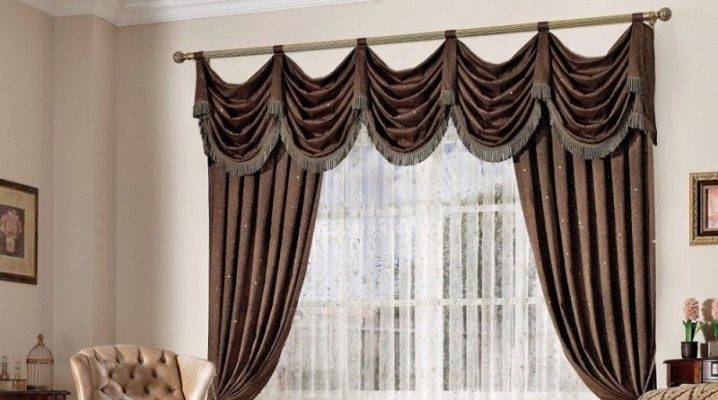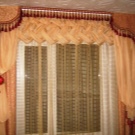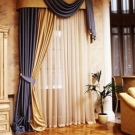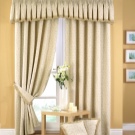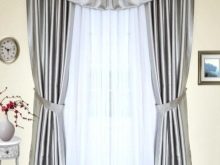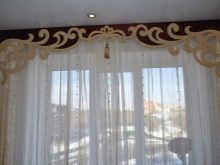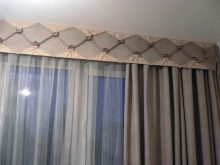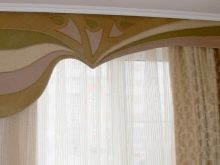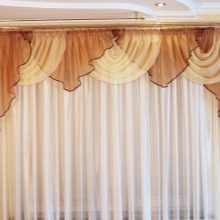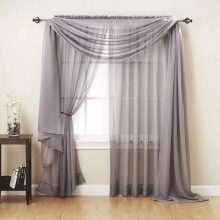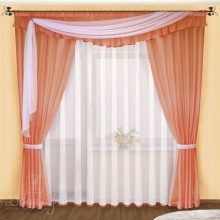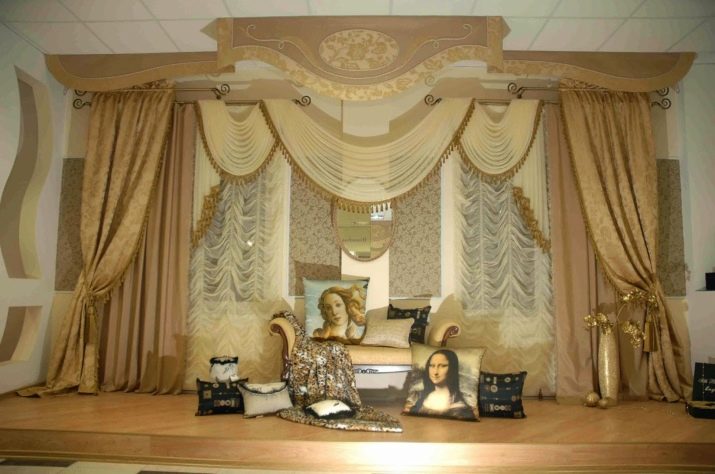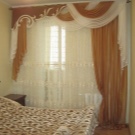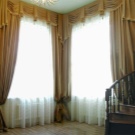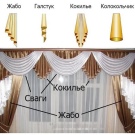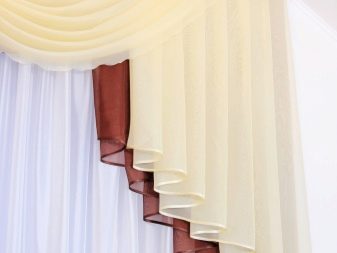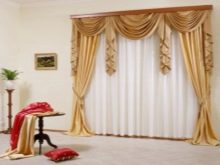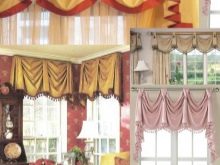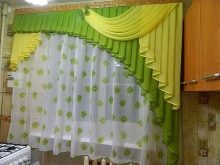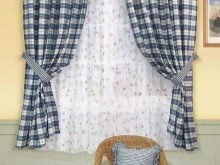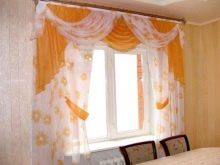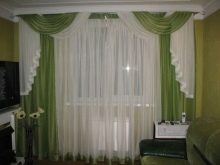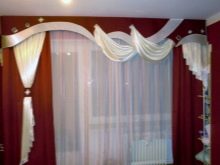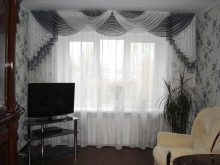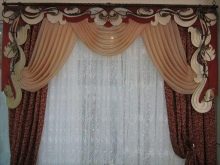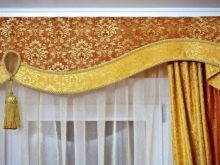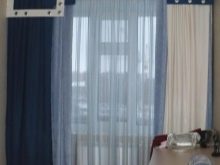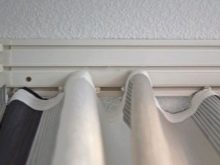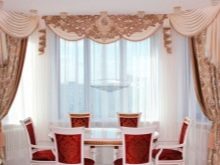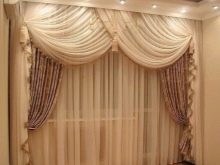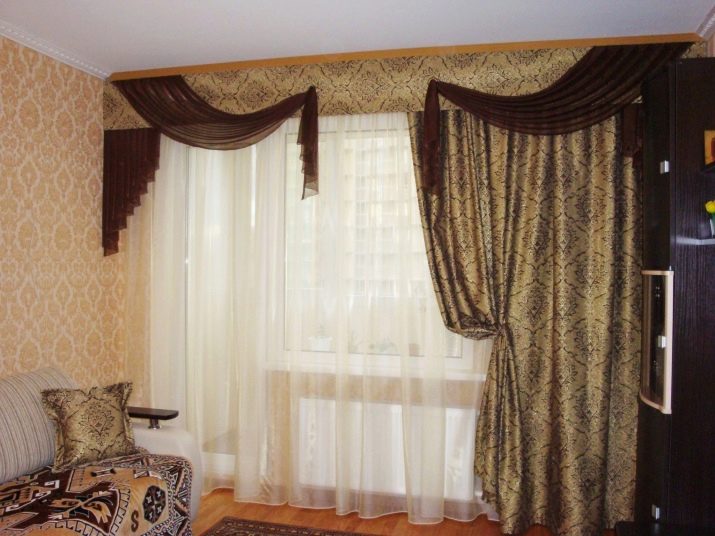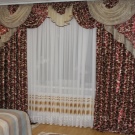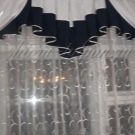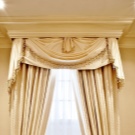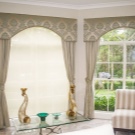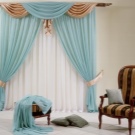Types of curtains with lambrequin and tips on choosing
Curtains with lambrequin are becoming popular again. The secret lies in their versatility: with the help of this decor you can arrange a window in any of the rooms - from the living room to the bedroom, and all because there are so many types of lambrequins, you can choose beautiful models for every taste and budget.
What are they?
Lambrequin is a detail of curtains that goes over the main curtain (or curtains, if the composition consists of two canvases of the same size). The lambrequin does not perform any functions other than decorative, however, sometimes there is a cornice behind it.
Initially, this detail was conceived precisely in order to hide the place of attachment of the curtains to the wall.
Previously, this element could be found only in classical and neoclassical interiors,since the lambrequins were sewn exclusively from draped fabric of the curtain, in most cases from the same fabric from which the curtain fabric itself was made. Currently, it can be used in almost any style of decoration of the room, because now the lambrequins are given not only a soft, but also a frame shape. They can be glued onto a special material over the main curtain composition or hanged in several layers of a flying, thin veil.
With the help of this element of decor you can arrange not only thick, but also light curtains of similar material.
Species
All lambrequins are divided into three groups:
- hard (gang);
- soft;
- combined, in which rigid parts are combined with soft.
The first can decorate any style of interior. In most cases, the gang is made in the form of a straight or figured plank that runs along the eaves and closes it. Planck can have a solid base (frame made of wood), and soft (flizelin or any other dense material).
Now popular openwork gang, most often made to order. Such an element of decor always attracts attention and, if properly fed, looks gorgeous.Rigid lambrequins are good at decorating rooms with low ceilings, while soft ones are suitable only for those rooms whose height is not less than 2.5 meters.
Of the soft types, the most common are voile and satin models. Atlas always adds room chic and sophistication and is best suited to the living room. As for the veil, it gives the interior airiness and lightness and will look good in the bedroom or in the nursery.
However, while making out the room in which the child or adult will sleep, you need to remember that the curtains, in addition to beauty, must protect at night from light penetration.
But do not think that the choice is limited to certain materials. The fabric can be any, even with the help of threads it is possible to form a light and original pelmet. It is permissible to use chintz, cotton, flax, silk, velvet, taffeta, organza and everything that is enough imagination for different rooms!
Soft lambrequins are usually divided into the following types.
- Svagi - folds of arcuate shape.
- Kokilje - vertical folds gathering at a sharp angle. The element is located in the center above.
- De jabot (jabot) - asymmetric detail with a beveled corner on the side of the curtains. The long part is directed outward, and the short - to the center.
- Tie - narrow detail, folded like an accordion.
- Bell - a piece of fabric, folded in the shape of a cone. For its manufacture uses a hard drape fabric.
Consider each view a little more. So, in order to make a swag, webs of fabric need to be gathered and formed into a semicircle or several semicircles from the resulting folds. Svagi can be located both symmetrically relative to each other, and fantasy. As a rule, windows decorated with such a technique look very beautiful, the room is filled with comfort and refinement at the same time.
For jabot one can use both curtain fabrics and light flying ones. The de jabot folds have beveled edges, the elements themselves are located at the edges of the lambrequin. Since this element is romantically different, it can be used in the nursery or in the bedroom.
No less interesting is the jabot in the kitchen, if it is combined with the dining room and decorated in the appropriate style. To highlight the kitchen area, you can use shorter elements,and in the dining room - long in line with the style.
Kokilje is an acute-angled element assembled from vertical folds. Located in the center of the lambrequin. It is advisable to use it only in a room with high ceilings and a large enough area, otherwise it will simply “get lost” or look alien.
Another element located laterally lambrequin - a tie. It is also composed of folds arranged vertically. The bottom of the tie is beveled. Often, this element in the decor is combined with Svagi. Mostly ties are used in a classic style of interior decoration.
Bell bells or sockets are suitable not only for Provence and classics. The conical shape and the possibility of using different materials will allow to “fit” the bell in almost any other style.
Color spectrum
Today there are no restrictions on the use of color for window decoration, it all depends on the owner’s imagination, as well as the area and height of the room to be decorated. Traditional curtain colors remain the most popular for decorating the hall: beige, bordeaux, gold, silver, steel, as well as brown and pink tones.The bedroom often uses shades associated with comfort and peace - peach, beige, pink and delicate green - mint, pistachio, spring foliage. Lilac tones are also popular, but they look organic only in combination with similar colors in the interior - lavender, indigo, violet.
Lambrequin in the kitchen is most often sewn from the same fabric as the curtain. It can be made in “cheerful” red and orange tones and decorated with a cage, peas, flowers (both small and large), for example. It all depends on the style in which the kitchen is decorated.
For country and Provence it is organic to use the same fabric for decorating windows and sewing the rest of kitchen textiles - towels, napkins, oven gloves, chair covers. It is more expedient to make a set to order, taking a natural fabric - chintz, calico, cotton. Such things wash well, they are environmentally friendly. If you order several similar sets, you can change them according to your mood, at the same time updating the interior of the kitchen.
In spacious rooms, for example, in a hall with a large area and windows in the floor (most often this can be found in country houses), reception using two or three shades in decorating window openings is relevant. It can be both tones of one color, and contrast.This choice is due to the fact that the windows decorated in this way become the accent of the room.
Some adherents of the traditional ways of decorating windows are biased against rigid lambrequins. Although it is they who are able to disguise a simple, laconic cornice and give chic and elegance to the room. The use of fabric for a gang, similar to the upholstery of furniture, makes the interior unusually stylish. In addition, you can make this type of lambrequin carved, give any desired shape to a stiff fabric and eventually create a real masterpiece of interior decor.
It is not necessary to also place the pelmet along the entire length of the curtain composition. You can order or buy a corner or any other fancy lambrequin and place it on one side.
How to hang?
Each type of lambrequin fastens differently. Bando often keeps on the eaves with the help of a stitched velcro. Soft models are fixed to the eaves in front of the curtains.
It is important to know that when choosing curtains with lambrequin, the eaves must be no less than three rows and at the same time necessarily baguette. Sometimes swags or metal molds are sewn into the curtain fabric and do not require a separate eaves row.
Interesting and original model-gang on a soft frame, which are mounted on the grommets or rings. The eaves then, as it passes through them, are no longer hidden, but, on the contrary, are part of the composition. In order for the ensemble to look organic, the eaves design must be round. Perhaps the cornice will have to make to order.
How to choose?
When decorating a room for the first time, it is better to study in advance the photos that are presented in large quantities in the network or interior design magazines, especially if you have never had to deal with the independent decoration of the rooms before. Then you should start from what you liked, considering the peculiarities of the room in which you plan to place the composition.
The easiest way is to buy ready-made curtains complete with lambrequin.
As a rule, all the options presented in the salons of curtains are quite versatile, beautiful and practical. However, if the chosen decor option is slightly different from the traditional, the purchase may be a problem.
Then you need to contact a specialist in sewing home textiles. Well, if the fabric is already selected, and the measurements taken from the window.You will only need to come with a photo, material and measurements, and the professionals will do everything for you. You should not be afraid of originality or atypical use of materials, because you live in the chosen interior, and only you know what it should be.
About what fabrics to use for lambrequins, described in the next video.
